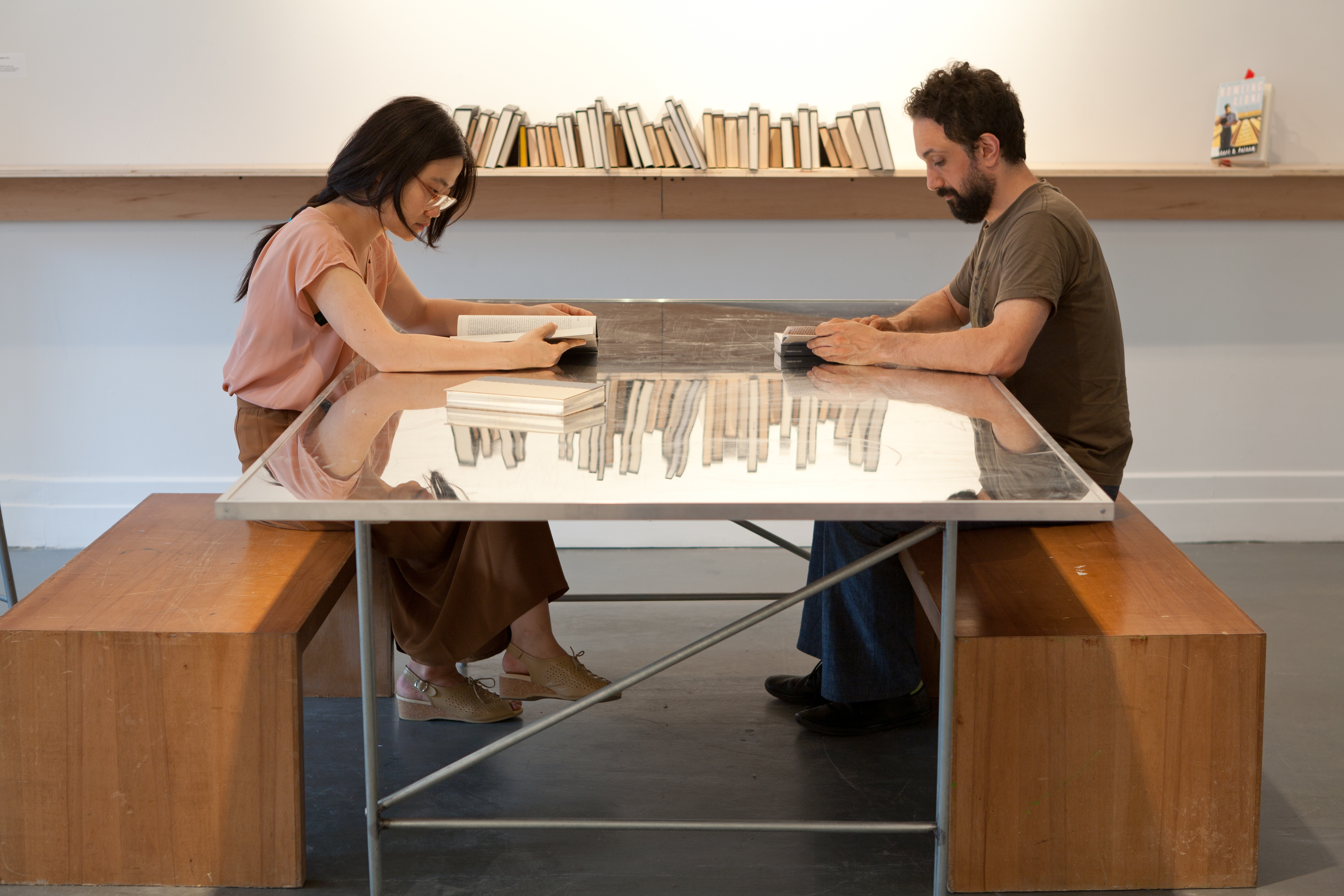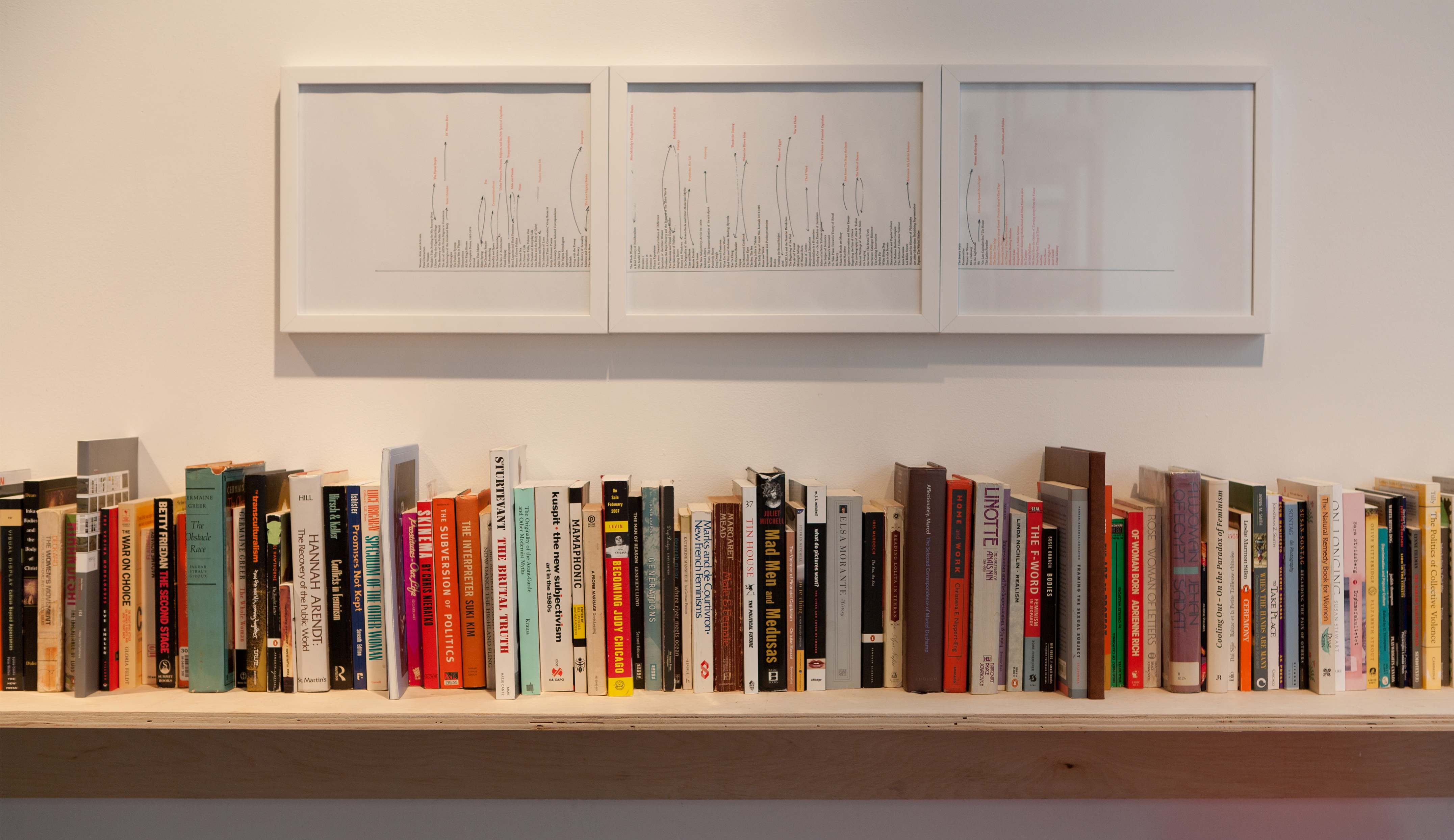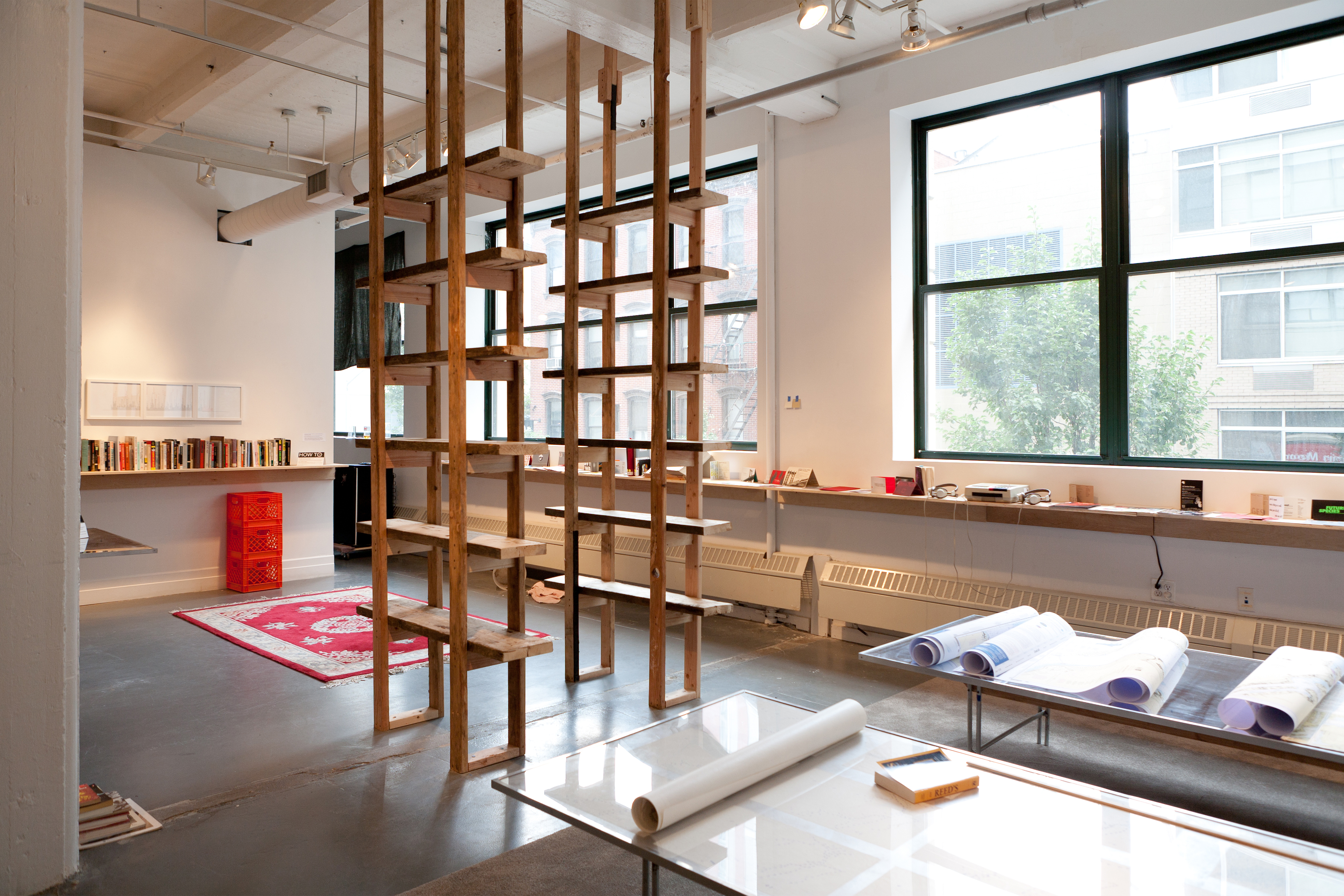
In its final weekend, (The Missing Library) organizer and artist, Annie Shaw, sat down with our intern Katie to talk about the show, the Dumbo Library, and what a bookshelf says about a its owner(s).
Katie: Where did the idea for (The Missing Library) come from? Were you approached to do a show or was the library theme something you pursued on your own?
Annie: I was invited by [Dumbo Arts Center Director] Karl Erickson. Karl knows quite a bit about my history and had given me full support to do anything I wanted. That said, I think we both understood my interests would be something about engaging the community.
I was very much inspired by his inaugural speech [as Director of Dumbo Arts Center]. When he started his position at the gallery, he talked about how he wanted to see Dumbo Arts Center become a community center for the residents of Dumbo. When he invited me to do the show, I took that idea very literally and thought about what it would mean to create that community space.
I also had in mind the artists I wanted to work with and have conversations with throughout the show. And as we started talking, all of them had been developing information-based work. From Marie’s Tideshow, to Angie’s Unknown Unknowns or Michelle’s alphabet project. I also wanted to invite Jen and Liz to do something related to their series of feminist reading group events. Eventually, I started to think about what it would mean to develop a library featuring their work. Through research, I learned that, in Dumbo, there have been attempts at building both community centers and libraries. But both of these failed because of financial constraints or real estate issues. That actually further convinced me that (The Missing Library) would be an interesting thing to work on.

K: What were your initial goals going into the show, if any?
A: I wanted to see if it was possible to engage with Dumbo residents. Also, because it’s a summer show, I wanted to take advantage of this time of year and use it to create a different atmosphere. How this would be done was quite abstract in the beginning. I also wanted to get to know more about the artists, and this created a formal platform for me to learn about their work.
I think also, my concern was that my time was limited. For any genuine social engagement [to happen] it requires a much slower, longer time and more consistency than four months preparation and an 8 week show can offer.


Q: Now in it’s final weekend, do you think (The Missing Library) was able to achieve these goals?
A: I certainly feel like I did get to know the artists’ work and the artists got to know each other’s work more. It was nice to get to know each other in this intimate way. I know that it’s not easy for the artists to show their work in such a contextualized setting. I would like to acknowledge that they have made many leaps of faith throughout the process. Not just faith in their own work but in each other’s work and also in my role [as artist and organizer], which can be blurry.
As far as engaging with the Dumbo community, some aspects were different than expected but I think this is a nice beginning. To be honest, at first I wasn’t sure if (The Missing Library) could even be a beginning. But I do come out of this experience feeling that this show was able to bring Dumbo Arts Center, and its new location, to the neighborhood in a new way. And it seemed, at least to me, that a few community members got more and more interested in (The Missing Library) and the center throughout the show, so that I feel very happy about.

K: There’s a lot to learn from the way a community reacts to your shows and you seem very interested in hearing visitors reflect on their experience with (The Missing Library). Could you explain what you’ve noticed over the course of this show?
A: You know the radio program and the New York Times article I sent you? Both are about how libraries are in crisis, how they are disappearing. After reading your article, I wrote you about my take on how the role of the library is changing.
During Lori Brown's talk, for instance, Lori spoke about how her proposal for the Matilda Joslyn Gage Library included a lot of space for programming, how she understood that the site had to function beyond archiving books and letters. Thinking about her presentation, reading your review, along with the process of thinking about what it means to create a library without many books, I came to realize that when a library is not all about book exchange, to me, it’s not necessarily a crisis.
Libraries have always been community centers, especially local public libraries. Each one kind of reflects the needs of the neighborhood. No library can have all the books in the world; it’s always constructed based on selection. Sometimes that’s based on what’s donated to them, what they can acquire and it is often dependent on who the librarians are and their choices. A lot of the time, the librarian plays the role of mediator, understanding the community’s needs. Of course, as books are being digitalized and reading experiences are changing, the physical books and their management are changing too.
In terms of the book lending in the Dumbo Library, I would actually like to see it remain at DAC for three or four more months. I don’t think that usage of the book borrowing will be all that common but people will be glad that space, that opportunity exists. That was kind of an interesting realization for me that in a way, the library is a sculpture, maybe a monument, at least a representation. A lot of the books we got were clearly used by the people of Dumbo. This type of representation is going to become more and more important for local libraries. And that was something I didn’t really expect.

K: Kind of like the books, or types of books, that are being donated to the library are indicative of the personality of Dumbo and the people living here. Almost like a neighborhood bookcase we can browse through.
A: Absolutely, yeah. Actually since you processed a lot of the donated books, I wanted to ask you what is the character of these books, what do you think is the color of this neighborhood after looking through their donations?
K: Definitely an educated crowd. There were a lot of what I’ll call “classics,” and not only literature but also critics like Walter Benjamin…the kind of books and essays that intellectual crowds use as a conversation piece. Faust, A Portrait of the Artist as a Young Man, Homer’s Illiad but then things by Charlotte Bronte and Steinbeck, I saw a Bukowski book too and I made sure A Heartbreaking Work of Staggering Genius made it in the library. I think these books are very indicative of the neighborhood, one that is younger, very educated, “hip,” and definitely artistic but not in the starving artist way.
A: Definitely, professional. I saw quite a few tax books too.
K: Exactly. But tax books for fine arts nonprofits. Stuff like How to Sell Your Art or The Law in Plain English for Galleries. And then there are also some funny ones like the book version of Stuff White People Like.
A: There was also that book about Mankind, the pro wrestler, his biography. When I saw that book I have to confess I thought "someone was reading this ironically."
K: Yeah, which is also very fitting for this community. The fact that I felt these kind of ridiculous books had a place in the Dumbo library, even if they weren’t going to be read seriously like the classics, is interesting too.


A: Right. In the beginning we were very focused on the donation and a part of me was very interested in how you [interns] would filter it, you know? To be very honest, it’s a conversation between you guys, between your perspectives too.
That’s part of socially engaged work. In reality, I could not possibly be there every day so I feel like for a lot of these exchanges we rely on you guys as channels between the gallery and the community. And we forget how important that is, how really you shape what this representation of Dumbo says. So I wanted that process to be visible and documented somehow. That was something I was really thinking about.
K: Right. I learned about that selection process in my writing classes. How, as soon as you choose to omit or include something, you fictionalize, or alter, your account.
A: Right. Or you’re creating an alternative narrative. And with the Dumbo Library donations, as much as there was a lot of enthusiasm, it’s really through a small group of people. So what is omitted really is the larger community. And on top of that, it’s still somebody’s unwanted collection. I’m interested that. That this is what they were able to part with, you know? These books are the ones they didn’t feel the need to display on their personal bookshelves. It’s interesting to think about what it means to collect people’s [or a community’s] unwanted items.
K: Yeah. And what Dumbo’s discard book pile says about its personality too.

No comments:
Post a Comment